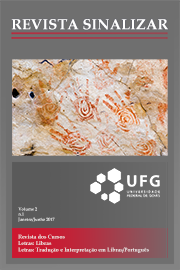Brazilian sign language: a reflection about the relationship between information asymmetry and welfare
DOI:
https://doi.org/10.5216/rs.v2i1.41802Keywords:
Information asymmetry, Sign Language, Welfare.Abstract
This article is about an experience report of conclusions drawn by a teacher working in a professional Sign Language course. We present a brief discussion on the term asymmetry of information relating it to the welfare concept. We also talk about creating laws that promote the Brazilian Sign Language (Libras) and point out the benefits that Libras students had while learning the new language. The classes were part of a project of the Department of Labor and took place at Delta College in the city of Goiania. Most of the researches done show the difficulties that permeate the communication of the deaf subject; in this report, however, the goal is to show that the lack of knowledge of the language is also detrimental to the listeners. The relevance of the work is justified by the need to create public policies that encourage the dissemination and expansion of the use of Sign Language in the country as a crucial factor in breaking down language barriers.
Downloads
References
BRASIL. Decreto nº 5.626 de 22 de dezembro de 2005. Regulamenta a Lei 10.436 que dispõe sobre a Língua Brasileira de Sinais e o Art. 18 da Lei nº 10.098 de 19 de dezembro de 2000. Disponível em: <http://www.planalto.gov.br/ccivil_03/_ato2004-
/2005/decreto/d5626.htm>. Acesso em 28 de maio de 2014.
BRASIL. Lei nº 10.436 de 24 de abril de 2002. Dispõe sobre a Língua Brasileira de Sinais –Libras e dá outras providências. Disponível em:<http://www.planalto.gov.br/ccivil_03/leis/2002/l10436.htm>. Acesso em: 09 de maio de 2014.
DIZEU, Liliane Correa Toscano de Brito; CAPORALI, Sueli Aparecida. “A língua de sinais constituindo o surdo como sujeito”. Educação e Sociedade, Campinas, v. 26, n. 91, p. 583-597, Maio/Ago. 2005.
MACEDO, Lino. Benefícios da aprendizagem da Língua de Sinais para todos. 2013. Disponível em: <http://diversa.org.br/artigos/artigos.php?id=600&/beneficios_da_aprendizagem_da_lingua_de_sinais_para_todos>. Acesso em: 2 abr. 2014.
PINDYCK, Robert S.; RUBINFELD, Daniel L. Microeconomia. 8. ed. São Paulo: Pearson Education, 2013.
SOUZA JÚNIOR, Marcos Antônio. Libras promove a inclusão. 2007. Disponível em: <http://www.medicina.ufmg.br/noticias/?p=331>. Acesso em: 2 abr. 2014.
STIGLITZ, Joseph E. Economics of the Public Sector. 3. ed. New York: Norton, 1999.
VARIAN, Hal R. Microeconomia: uma abordagem moderna. 8. ed. Rio de Janeiro: Campus, 2012.
Downloads
Published
How to Cite
Issue
Section
License
Copyright

This work is licensed under a Creative Commons Attribution-NonCommercial-NoDerivatives 4.0 International License.
Autores que publicam nesta revista concordam com os seguintes termos:
Autores mantém os direitos autorais e concedem à revista o direito de primeira publicação, com o trabalho simultaneamente licenciado sob a Creative Commons Attribution License que permitindo o compartilhamento do trabalho com reconhecimento da autoria do trabalho e publicação inicial nesta revista.
Autores têm autorização para assumir contratos adicionais separadamente, para distribuição não-exclusiva da versão do trabalho publicada nesta revista (ex.: publicar em repositório institucional ou como capítulo de livro), com reconhecimento de autoria e publicação inicial nesta revista.







